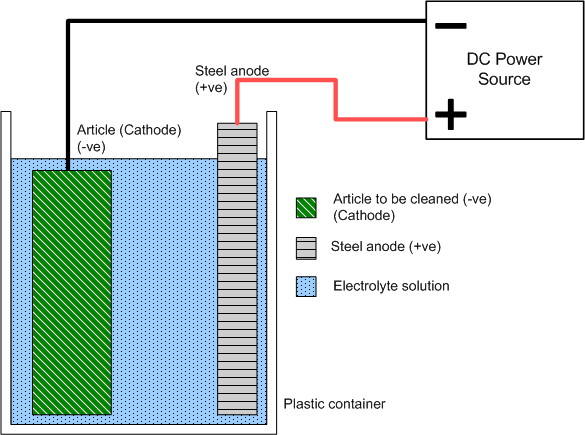Cleaning metal parts (car or other parts you want to restore) is time consuming and often the result is not what you'd expect. The tutorial will guide you through the process of making a simple chemistry work for you while having a barbecue with your friends.
Definitions:Source: WikipediaElectrolysis: a technique that uses a direct electric current (DC) to drive an otherwise non-spontaneous chemical reaction.
Anode: an electrode through which conventional current flows into a polarized electrical device.
Cathode: the electrode from which a conventional current leaves a polarized electrical device.
Illustration of the process:Source: http://www.smex.net.au/reference/RustRemoval04.php Electrolysis versus Sand-blastingElectrolysis
Electrolysis versus Sand-blastingElectrolysis- Less physical work, better results. The hardest part is setting up the environment
- Won't damage your health (if you do it the right way and follow the safety guide)
- The surplus water can be poured down. It has a lot of Ferrum in it therefore it's useful to your grass
- 100% rust elimination is possible (you still have to prevent rust)
- Won't damage your part (won't react with a rubber)
- For larger parts you just need a larger environment
Sand-blasting- Doesn't get into the metal pours, rust will continue damaging a metal immediately
- You need special equiptment (can be expensive)
- Often not possible to work at home
- Small details are hard to clean
Safety- No smoking
- No sparks
- Hydrogen and oxygen are the main components of gas bang which occurs if the temperature increases suddenly. Make sure you don't try this in your living room
- Use safety glasses
- Use safety or rubber gloves
What do you need?- Na2CO3 - sodium carbonate or NaHCO3 - sodium bicarbonate. Both will work. Sodium bicarbonate is perhaps easier to get (most food stores)
- Battery or a charger (12V)
- A pair of jumping cables
- Electrode (old brake disc or a metal rod will do)
- Plastic bucket
- Water
- A part(s) you want to clean
So I got all the things mentioned above, what next?- Fill your plastic bucket with water. A detail you want to clean has to be fully under the water
- Add Na2CO3 or NaHCO3 (1 gup is enough)
- Put your anode in the solution (anode will catch the rust from your part). Make sure it's a bit larger than your detail.
- Put your part in the solution (cathode)
- Fasten the positive (-) cable to the part you want to clean
- Fasten the + cable to the anode
MAKE SURE anode and cathode won't touch each otherDon't fasten + and - the opposite way because then your part will catch all the rust from the anode rust.
Make sure you have a connection between the anode and cathode. You can test it with a light bulb.

After you have set your environment you will soon see some action in the bucket: tiny bubbles and fizzling noise. The water will take a rust color.
Example of the environment: More advanced...
More advanced...
The process is finished if you don't see any action inside the bucket. It can take anywhere between 6-12 hours.
Your detail don't look perfect right after the process. Use pressured air and blow away all the dirt and rust. Clean your detail(s) with a soap and warm water. After 1-2 minutes with a metal brush your part will shine.
 Paint and assembly:
Paint and assembly: I WILL NOT TAKE ANY RESPONSIBILITY OF YOUR ACTIONS. EVERYTHING YOU DO IS AT YOUR OWN RISK AND RESPONSIBILITY.
I WILL NOT TAKE ANY RESPONSIBILITY OF YOUR ACTIONS. EVERYTHING YOU DO IS AT YOUR OWN RISK AND RESPONSIBILITY.Your questions are welcome.
Thank you
Meigo